|
Helvetia
Author: Matthias Cramer
Publisher: Kosmos
Year: 2011
review by

| x |
|
|
|
|
|
|
|
|
|
|
|
|
|
|
|
|
|
|
|
|
|
|
|
|
|
|
|
|
|
|
|
|
|
x |
|
|
|
|
|
|
|
|
|
|
|
|
|
|
|
|
|
|
|
|
|
|
|
|
|
|
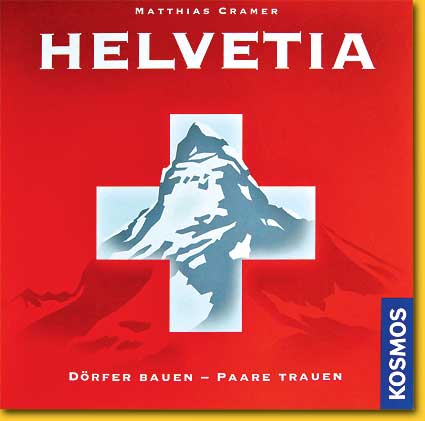 |
We are the chiefs of several isolated Swiss villages, shortly after the end of the Napoleonic occupation. The villagers long to build a thriving community after years of suppression. How this could be achieved is incorporated as a hint in the box cover illustration: "Dörfer bauen, Paare trauen". In other words, players try to achieve something by herding cows and goats, and marry their children into a neighbouring village, preferably to someone who does something creative with bread or ore. Of course love and marriage is followed by the proverbial baby carriage, and so the village grows and prospers.
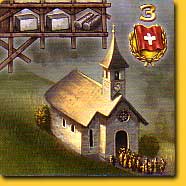
|
|
| x |
|
|
|
|
|
|
|
|
|
|
|
|
|
|
|
|
|
|
|
|
|
|
|
|
|
|
|
|
|
|
|
|
|
|
|
|
|
|
|
|
|
|
|
|
|
|
|
|
|
|
|
|
|
|
|
|
|
|
|
|
| Each player gets his own village center, and three starting buildings that produce a simple (basic) good. Everybody receives a collection of villagers in his colour, men and women. A production building can only produce goods when occupied by a villager; at the start of the game, all starting buildings are already occupied. All players start with four coins in their colour. In a player's turn, he places his coin(s) on one of the five characters depicted on the main board. |
|
| x |
|
|
|
|
|
|
|
|
|
|
|
|
|
|
|
|
|
|
|
|
|
|
|
|
|
|
|
|
|
|
|
|
|
|
|
|
|
|
|
|
|
|
|
|
|
|
|
|
|
|
|
|
|
|
|
|
|
|
|
|
| The builder allows players to build one building per coin; by placing two coins simultaneously, the player may therefore buy two buildings at once. The buildings have to be paid with goods, depicted in the upper left corner. To pay a good, an 'awake' villager (= standing) of his own colour on a building producing the desired good is laid down on his side, indicating that he has fallen asleep after the hard labour. To pay for a building that requires a wood and a stone, a villager on a wood producing building and on a stone producing building have to be 'put to sleep'. It is not important whether the building is situated in your own village or a neighbouring village, which can happen after marriage. |
|
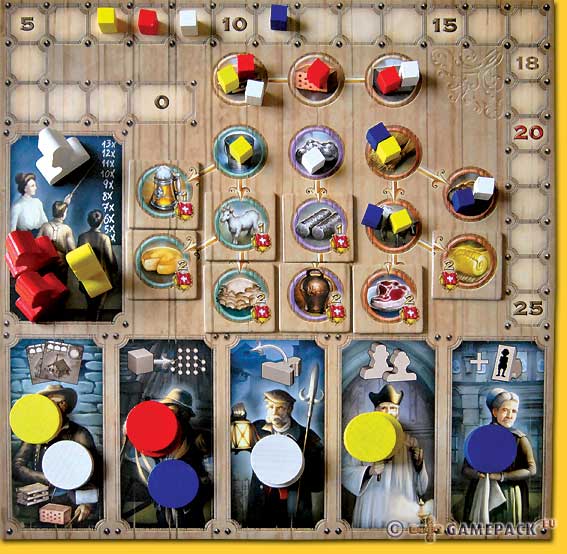 |
|
| x |
|
|
|
|
|
|
|
|
|
|
|
|
|
|
|
|
|
|
|
|
|
|
|
|
|
|
|
|
|
|
|
|
|
|
|
|
|
|
|
|
|
|
|
|
|
|
|
|
|
|
|
|
|
|
|
|
|
|
|
|
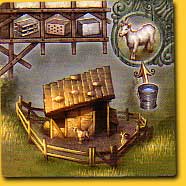 |
But it is not quite this simple! There are also 'complex goods' that are made from another good. For example, a goat is 'produced' using a bucket of water, so when paying with a goat, you also have to supply the water! There are even more complex goods that require two other goods, like grain becomes cow becomes butter. The new building is placed in the city immediately, and if there is a villager present in the village center, he moves into the building and it can be used from now on. |
|
| x |
|
|
|
|
|
|
|
|
|
|
|
|
|
|
|
|
|
|
|
|
|
|
|
|
|
|
|
|
|
|
|
|
|
|
|
|
|
|
|
|
|
|
|
|
|
|
|
|
|
|
|
|
|
|
|
|
|
|
|
|
|
The trader delivers goods to the market in the next big town in exchange for victory points. For each coin placed on the trader character, the player may transport one good to the market. This comes down to inactivating the appropriate villager(s) and placing a cube of his colour on the delivered good on the central board.
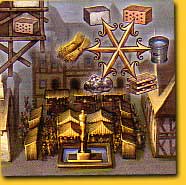
|
|
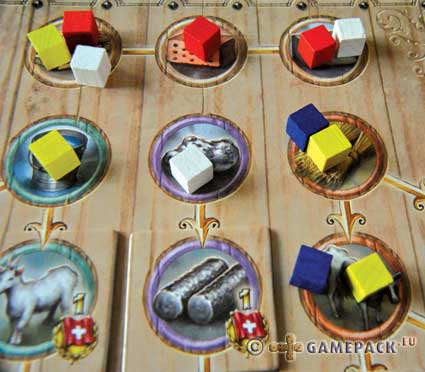 |
|
| x |
|
|
|
|
|
|
|
|
|
|
|
|
|
|
|
|
|
|
|
|
|
|
|
|
|
|
|
|
|
|
|
|
|
|
|
|
|
|
|
|
|
|
|
|
|
|
|
|
|
|
|
|
|
|
|
|
|
|
|
|
|
But how do we wake all these sleepy villagers? With the night watchman! For each coin the player places on this character, he may wake up an entire quarter of a village, either his own village or somebody else's. Everybody is awoken, also the villagers of other players!
The priest can be used to marry one of your unattached villagers. The villager can come from the village center, or even directly from school! You are never too young to marry, and what can you learn in a simple village school anyway... You have to marry someone in a neighbouring village, and of the opposite sex: gay marriage is still controversial nowadays, so in 1800 this was out of the question. If there happens to be a coin of your colour in the village center of the village you married into, you may take this coin as dowry and as such have an additional action to spend. In total every player can collect two additional coins this way.
|
|
| x |
|
|
|
|
|
|
|
|
|
|
|
|
|
|
|
|
|
|
|
|
|
|
|
|
|
|
|
|
|
|
|
|
|
|
|
|
|
|
|
|
|
|
|
|
|
|
|
|
|
|
|
|
|
|
|
|
|
|
|
|
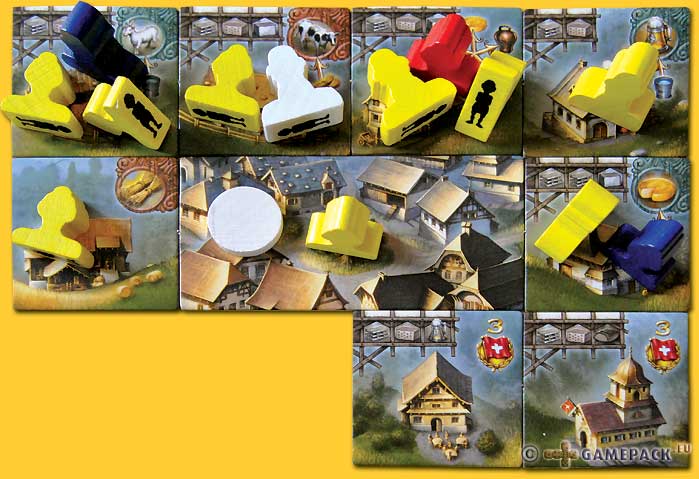 |
|
| x |
|
|
|
|
|
|
|
|
|
|
|
|
|
|
|
|
|
|
|
|
|
|
|
|
|
|
|
|
|
|
|
|
|
|
|
|
|
|
|
|
|
|
|
|
|
|
|
|
|
|
|
|
|
|
|
|
|
|
|
|
|
And after marriage comes: the midwife. This character can be used to produce babies in your own village. Each couple can have one baby per action. You are allowed to choose the gender; if you tip over a man or woman from your supply, a baby becomes visible, or rather: a scary, disfigured monstrosity without lower arms...
|
|
| x |
|
|
|
|
|
|
|
|
|
|
|
|
|
|
|
|
|
|
|
|
|
|
|
|
|
|
|
|
|
|
|
|
|
|
|
|
|
|
|
|
|
|
|
|
|
|
|
|
|
|
|
|
|
|
|
|
|
|
|
|
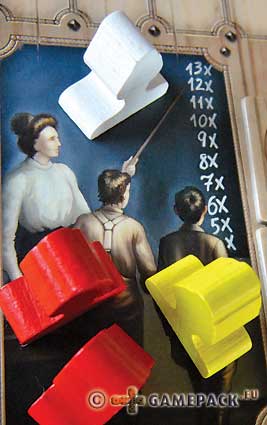 |
|
When there is only one player left that still has coins to spend, the round is over. This player becomes the new starting player. Of each character a small bonus tile is available, which is now awarded to the player having the highest number of coins on the corresponding character. This tile enables the player to perform the corresponding action once in the next round, without spending any coins. Next, the victory points are counted. Special buildings are worth 3 points, each cube on the market, the bonus character tiles and starting player tile al score one point, and the special bonus tiles score as many points as depicted. If a player has reached 20 points, the game is over, but if not, the next round commences. New buildings are added to the display, children leave school and go to the village center, and the newborn babies go to school.

|
|
| x |
|
| x |
|
| x |
|
 |
|
|
|
|
|
|
|
|
|
|
|
|
|
|
|
|
|
|
|
|
|
|
|
|
|
|
|
|
|
|
|
|
|
|
|
|
|
|
|
|
|
|
|
|
|
|
|
|
|
|
|
|
Although the trendy, stylish bright red box cover, showing a Swiss cross and a silhouette of the Matterhorn, suggests something totally, absolutely and completely different, Helvetia has beautiful and realistic illustrations. Unfortunately this compromises playability. The icons indicating the building costs and especially the function of the buildings are too small and seem to disappear against the dark and chaotic background.
|
|
| x |
|
|
|
|
|
|
|
|
|
|
|
|
|
|
|
|
|
|
|
|
|
|
|
|
|
|
|
|
|
|
|
|
|
|
|
|
|
|
|
|
|
|
|
|
|
|
|
|
|
|
|
|
|
|
|
|
|
|
|
|
| Add to this a man, a woman and a baby on top of the building tiles, and it becomes completely impossible to see what building is doing what. Since the idea of the game is to marry into neighbouring villages and use their buildings, this is a major drawback. 'Can you tell me what my villager over there in your village is producing?' -that's no way to plan your turn. |
|
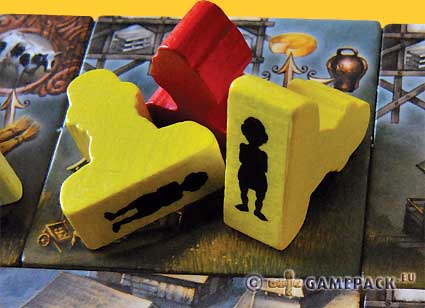 |
|
| x |
|
|
|
|
|
|
|
|
|
|
|
|
|
|
|
|
|
|
|
|
|
|
|
|
|
|
|
|
|
|
|
|
|
|
|
|
|
|
|
|
|
|
|
|
|
|
|
|
|
|
|
|
|
|
|
|
|
|
|
|
 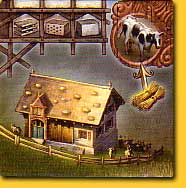 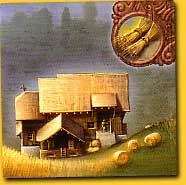 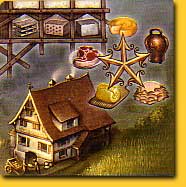 |
| x |
|
|
|
|
|
|
|
|
|
|
|
|
|
|
|
|
|
|
|
|
|
|
|
|
|
|
|
|
|
|
|
|
|
|
|
|
|
|
|
|
|
|
|
|
|
|
|
|
|
|
|
|
|
|
|
|
|
|
|
|
|
Additionally, there are too many buildings with different costs, goods and possibilities, resulting in a tremendous headache. It happens all too often that a player thinks he has it all figured out, but on the way realises that he is still lacking one good for his master plan. And then, after already countless villagers have been deactivated, it is a nice challenge to return the game board to its original state... This plethora of possibilities results in very long turns: analysis paralysis! Especially the 'trade' buildings that allow the exchange of one depicted good for another add to the chaos, since they result in virtually endless possibilities that all have to be considered. And the complex goods, especially in combination with 'trade' buildings, can require inactivation of as much as five villagers for the production of just one good! The night watchman can hardly compete with this rate of inactivation! In conclusion, Helvetia is a chaotic game, with hard work and little play.
|
|
© 2012 Barbara van Vugt
Helvetia, Matthias Cramer, Kosmos, 2011 - 2 to 4 players, 12 years and up, 60-90 minutes
|
|
  |
|
|
|
|
|
|
|
|
|
|
|
|
|
|
|
|
|
|
|
|
|
|
|
|
|
|
|
|
|
|
|
|
|
|
|
|
|
|
|
|
|
|
|
|
|
|
|
|
|
|
|
  |
Very flat and difficult to distinguish symbols; Vohwinkel does not draw, he merely sculpts -not quite my style |
  |
  |
|
|
|
|
|
|
|
|
|
|
|
|
|
|
|
|
|
|
|
|
|
|
|
|
|
|
|
|
|
|
|
|
|
|
|
|
|
|
|
|
|
|
|
|
|
|
|
|
|
|
|
  |
|
|
|
|
|
|
|
|
|
|
|
|
|
|
|
|
|
|
|
|
|
|
|
|
|
|
|
|
|
|
|
|
|
|
|
|
|
|
|
|
|
|
|
|
|
|
|
|
|
|
|
  |
Original mechanism; plays smoothly after the initial hurdle is taken. A game that captivates |
  |
  |
OK game, but too much of a hassle |
| x |
|
|
|
|
|
|
|
|
|
| x |
|
|
|
|
|
|
|
|
|
|
|
|
|
|
|
|
|
|
|
|
|
|
|
|
|
|
|
|
|
|
|
|
|
|
|
|
|
|
|
|
|
|
|
|
|
|
|
|
|
|
|
|
|
|
|
|
|
|
|
|
 |
|
|
|
|
|
|
|
|
|
|
|
|
|
|
|
|
|
|
|
|
|
|
|
|
|
|
|
|
|
|
|
|
|
|
|
|
|
|
|
|
|
|
|
|
|
|
|
|
|
|
|
 |
|
|
|
|
|
|
|
|
|
|
|
|
|
|
|
|
|
|
|
|
|
|
|
|
|
|
|
|
|
|
|
|
|
|
|
|
|
|
|
|
|
|
|
|
|
|
|
|
|
|
|
| x |
|
|
|
|
|
|
|
|
|
|
|
|
|
|
|
|
|
|
|
|
|
|
|
|
|
|
|
|
|
|
|
|
|
|
|
|
|
|
|
|
|
|
|
|
|
|
|
|
|
|
|
|
|
|
|
|
|
|
|
|
 |
|
|
|
|
|
|
|
|
|
|
|
|
|
|
|
|
|
|
|
|
|
|
|
|
|
|
|
|
|
|
|
|
|
|
|
|
|
|
|
|
|
 |
|
|
|
|
|
|
|
|
|
|
|
|
|
|
|
|
|
|
|
|
|
|
|
|
|
|
|
|
|
|
|
|
|
|
|
|
|
|
|
|
|
|
|